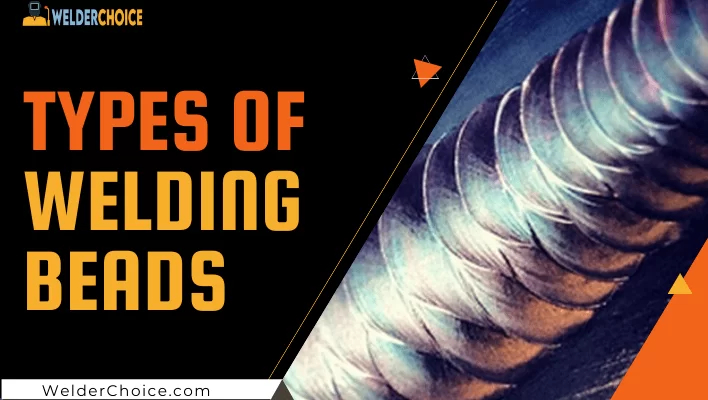This article will go through the different types of welding beads used in the different welding processes (TIG, Stick, MIG). Understanding the various bead varieties can assist you in selecting what is suitable for your projects and requirements.
To achieve diverse bead profiles, we like to think of employing welding patterns.
A filler material is placed into a joint between two metal plates to generate a weld bead.
A perfect welding beads pattern will address all of the welding issues.
Types of Welding Beads
There are different types of welding beads produced based on how much vibration occurs during welding.
This procedure is used to apply the filler material to the surface. When the welder requires lower vibrations, a narrow bead called a “stringer bead” is generated.
Weld Bead Size
The weld bead size is created of the weld’s height and width. These two characteristics describe the weld’s quality and assist us in obtaining the smallest possible defects.
The welding current and arc speed could impact the size of the weld bead.
The width and height of the bead expand in sync.
TIG Welding Beads
The appearance of TIG welding beads is similar to that of a stack of dimes. This is because the welder uses their other hand to add evenly spaced “dabs” of filler metal as the TIG arc travels.
When these dabs are layered on top of each other, they form a circular shape. The order in which the dabs are applied has a significant impact on the appearance of the weld.
If you feed the filler metal faster, the dimes will be closer together, and vice versa. Because of this, TIG welds can be some of the most attractive welds.
TIG welds do not always give the appearance of a stack of dimes. Welders will occasionally “walk the cup.” And that is where the filler wire is secured when it is lying on the welded piece. As they progress through their weld, the welder walks the TIG cup back and forward.
Imagine spreading cream cheese on a bagel as the filler rod melts and spreads across the weld joint. This method is widespread among pipe welders. To increase the amount of filler deposited, two or three filler rods may be utilized simultaneously. Consider walking the cup as “weaving” rather than a straight weld.
Stick Welding Beads
Stick welding has a variety of bead properties. The rods in the low hydrogen family have a variety of applications. A number of hydrogen rods, including a low hydrogen rod, can be used. These beads make it simple to make a straight bead.
In addition, these beads are much smaller than others. A weaving pattern is ideal in vertical welding. As a result, the welder can spread the filler material in various designs on the alloy surfaces.
Stick welding beads can also be made using cellulose stick rods. These should be handled with caution. It resembles a coin in shape, and the finished product has the appearance of a TIG weld. These welds, on the other hand, are not as attractive as TIG welds.
The welder can also strike an arc using this technique while holding the rod in place to generate a coin-like shape.
MIG Welding Beads
Hardwire MIG is very adaptive because there are so many different ways to make a good weld. Some people enjoy dragging the puddle, while others prefer pushing it. The debate over whether pushing or pulling is more strong has lasted for centuries.
Because there is no flux coating in hardwire MIG, the operator does not need to drag their puddle. “If it has slag, you got drag,” as the welding idiom goes. This is because if you use a stick rod or flux core MIG gun, most of the slag will get caught in the weld.
As a result, porosity occurs. As you go with flux coated welding techniques, the dragging approach allows the slag to build up and harden towards the back of your puddle.
Many MIG welders will not weave or apply any pattern. They’ll connect a few beads in a straight line. Because the filler metal is stretched out more, the bead becomes flatter. Although a sound weld can be made in this manner, a weaving pattern can be advantageous for larger joints and vertical welds.
The “MIG like TIG” fad is a relatively new phenomenon. Specific MIG settings can result in a bead that looks like the TIG dimes we talked about earlier. This is due in large part to a technique that uses a slow wire speed.
Because the low heat penetrates the metal even less than typical, these beads aren’t as strong as they may be. However, they have become popular in the off-roading community (especially on car parts).
Flux Cored MIG Beads
Flux core MIG can deposit a huge amount of filler quickly. The bulk of flux cored beads are run on simple stringers. Vertical flux cored welders typically require weaving to handle the puddle. If you weave a flux cored bead somewhere through the weld, you won’t get a “drip”. This happens when the weld gets too hot, and the molten metal from your piece of material falls to the ground.
Conclusion
Welding jobs require a great deal of work and concentration. You can use any of the strategies listed above to get the most significant type of welding beads.
We’ve done our best to find all welding beads that will help you complete your welding job effectively. As a result, you may produce a good and appealing weld in all three welding methods, namely MIG, TIG, and Stick, by using different welding beads designs.
Recommended Articles
Auto darkening Welding Helmets

With 8 years of experience a senior welding instructor and safety equipment researcher and writes articles, reviews and guidelines on helmets and other welding and safety gears at Welder Choice, and other written works have been published in various publications.
